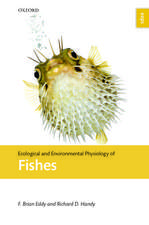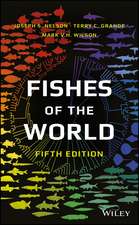Quantitative Ecology and the Brown Trout: Oxford Series in Ecology and Evolution
J. M. Elliotten Limba Engleză Paperback – 17 feb 1994
Din seria Oxford Series in Ecology and Evolution
-
 Preț: 321.54 lei
Preț: 321.54 lei - 25%
 Preț: 502.27 lei
Preț: 502.27 lei - 14%
 Preț: 353.15 lei
Preț: 353.15 lei -
 Preț: 325.98 lei
Preț: 325.98 lei - 18%
 Preț: 459.19 lei
Preț: 459.19 lei - 19%
 Preț: 439.25 lei
Preț: 439.25 lei - 13%
 Preț: 443.22 lei
Preț: 443.22 lei - 28%
 Preț: 376.06 lei
Preț: 376.06 lei - 34%
 Preț: 697.21 lei
Preț: 697.21 lei - 9%
 Preț: 296.35 lei
Preț: 296.35 lei - 14%
 Preț: 480.86 lei
Preț: 480.86 lei - 12%
 Preț: 424.74 lei
Preț: 424.74 lei - 18%
 Preț: 356.03 lei
Preț: 356.03 lei - 13%
 Preț: 443.36 lei
Preț: 443.36 lei - 13%
 Preț: 464.12 lei
Preț: 464.12 lei - 27%
 Preț: 377.84 lei
Preț: 377.84 lei - 41%
 Preț: 139.55 lei
Preț: 139.55 lei - 30%
 Preț: 718.17 lei
Preț: 718.17 lei - 38%
 Preț: 268.41 lei
Preț: 268.41 lei - 30%
 Preț: 590.27 lei
Preț: 590.27 lei - 30%
 Preț: 497.74 lei
Preț: 497.74 lei - 19%
 Preț: 351.87 lei
Preț: 351.87 lei - 18%
 Preț: 360.28 lei
Preț: 360.28 lei - 28%
 Preț: 375.06 lei
Preț: 375.06 lei - 28%
 Preț: 375.73 lei
Preț: 375.73 lei - 34%
 Preț: 802.62 lei
Preț: 802.62 lei - 19%
 Preț: 351.62 lei
Preț: 351.62 lei - 14%
 Preț: 437.87 lei
Preț: 437.87 lei - 30%
 Preț: 550.67 lei
Preț: 550.67 lei - 22%
 Preț: 400.41 lei
Preț: 400.41 lei - 19%
 Preț: 352.29 lei
Preț: 352.29 lei - 18%
 Preț: 354.05 lei
Preț: 354.05 lei - 28%
 Preț: 373.46 lei
Preț: 373.46 lei - 28%
 Preț: 495.10 lei
Preț: 495.10 lei - 8%
 Preț: 299.19 lei
Preț: 299.19 lei - 23%
 Preț: 464.29 lei
Preț: 464.29 lei - 28%
 Preț: 375.06 lei
Preț: 375.06 lei - 30%
 Preț: 592.43 lei
Preț: 592.43 lei
Preț: 375.55 lei
Preț vechi: 518.44 lei
-28% Nou
Puncte Express: 563
Preț estimativ în valută:
71.87€ • 78.04$ • 60.37£
71.87€ • 78.04$ • 60.37£
Carte tipărită la comandă
Livrare economică 11-17 aprilie
Preluare comenzi: 021 569.72.76
Specificații
ISBN-13: 9780198540908
ISBN-10: 0198540906
Pagini: 298
Ilustrații: line figures, tables
Dimensiuni: 156 x 233 x 18 mm
Greutate: 0.43 kg
Editura: OUP OXFORD
Colecția OUP Oxford
Seria Oxford Series in Ecology and Evolution
Locul publicării:Oxford, United Kingdom
ISBN-10: 0198540906
Pagini: 298
Ilustrații: line figures, tables
Dimensiuni: 156 x 233 x 18 mm
Greutate: 0.43 kg
Editura: OUP OXFORD
Colecția OUP Oxford
Seria Oxford Series in Ecology and Evolution
Locul publicării:Oxford, United Kingdom
Recenzii
Frost and Brown's work "The Trout" has rightly been the touchstone against which all subsequent publications on the species have been judged: Elliot has produced a text of equal importance to the modern trout biologist and at an affordable price!
All fish population ecologists will want to read this book. Its detail serves to illustrate the principles of population ecology, bringing alive concepts that in the abstract are hard to grasp and sometimes tedious. The book will help students, at all levels, to apply the principles they read about in textbooks, and the textbooks themselves will soon be drawing on Elliott's summary of his own research for both inspiration and illustration. Researchers will want to use the book as a source of ideas for their own work. These will all emphasize the excellent service Elliott has done for fisheries biology by carrying out the research and summarizing it in this splendid book.
This is a very carefully planned and well-written book. Its aims and overall structure are clearly outlined at the start and its conclusions spelled out as seven key points in the concludijng chapter. Elliott's style of writing is simple and concise ... As a result, the book provides a detailed and informative but easily-assimilated review of what must count as one of the key ecological studies of recent times. Felicity Huntingford, University of Glasgow, TREE, Vol. 10, No. 2, February 1995
All fish population ecologists will want to read this book. Its detail serves to illustrate the principles of population ecology, bringing alive concepts that in the abstract are hard to grasp and sometimes tedious. The book will help students, at all levels, to apply the principles they read about in textbooks, and the textbooks themselves will soon be drawing on Elliott's summary of his own research for both inspiration and illustration. Researchers will want to use the book as a source of ideas for their own work. These will all emphasize the excellent service Elliott has done for fisheries biology by carrying out the research and summarizing it in this splendid book.
This is a very carefully planned and well-written book. Its aims and overall structure are clearly outlined at the start and its conclusions spelled out as seven key points in the concludijng chapter. Elliott's style of writing is simple and concise ... As a result, the book provides a detailed and informative but easily-assimilated review of what must count as one of the key ecological studies of recent times. Felicity Huntingford, University of Glasgow, TREE, Vol. 10, No. 2, February 1995









